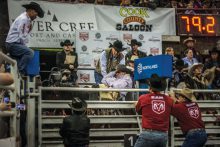
During the CFR you will hear the terms “Left Hand Delivery” or “Right Hand Delivery.”
Like people, livestock are either left or right handed and they deliver their best performance if they are given the opportunity to start out on their favourite side or lead. The stock contractors pay careful attention to their animals, and through years of experience and performance reviews, they soon learn their animal’s preferences.
In most rodeo arenas there are six chutes in total; three chutes with a right hand delivery, three chutes with a left hand delivery.
A right hand delivery means the horse (and rider) have their right side against the chute gate. A left hand delivery means the horse (and rider) have their left side against the chute gate. That’s the simple explanation, but I wanted to show you just how much attention stock contractors pay to their livestock.
For examples, check out the Stock Draws for Wed., Nov 9 – posted at
https://cowboycountrymagazine.com/2016/11/cfr43-stock-draws-for-wed-nov-9/
Under the category “Del” (which stands for Delivery) is the following combinations of letters:
- RM – right hand delivery; middle chute
- RF – right hand delivery; front chute
- RM-B – right hand delivery; middle or back chute
- LB – left hand delivery; back chute
- LM-B – left hand delivery; middle or back chute
- LM-F – left hand delivery; middle or front chute
So what happens if, for example, a bucking horse is loaded in the wrong chute?
“The worst possible thing,” says Shane Franklin, rodeo stock contractor and one of two stock contractor rep’s on the CPRA board. “If he’s used to being bucked out of one delivery, and gets loaded by mistake in the other there’s a chance of him backing out because he’s not used to turning out that way. The rule is that if any animal backs out of the bucking the rider is automatically awarded a re-ride,” he explains.
“I have some horses that I switch deliveries on,” Franklin continues. “If they turn and go right down tight against the bucking chutes, what you want to try and do on him is the next time, you load him in the other side and the gateman holds the gate only halfway open, 90 degrees not the full 180, and that should force the horse to go out further and get him away from the fence,” he explains. “But on saying that, all you’re doing is trying to trick him and we’re dealing with experts–and to trick an expert is awful tough.”












